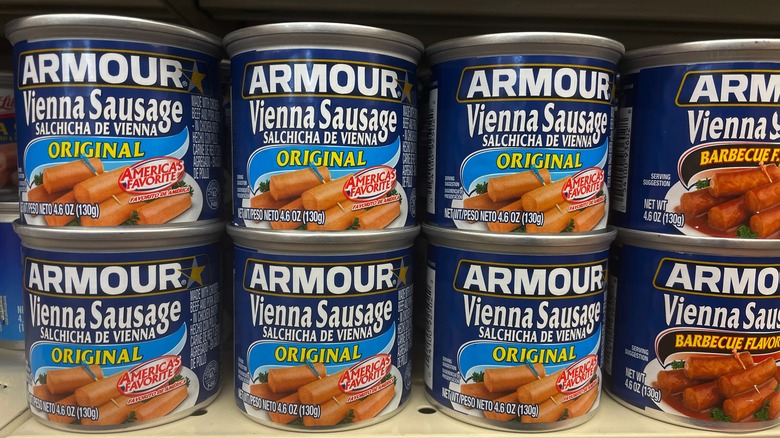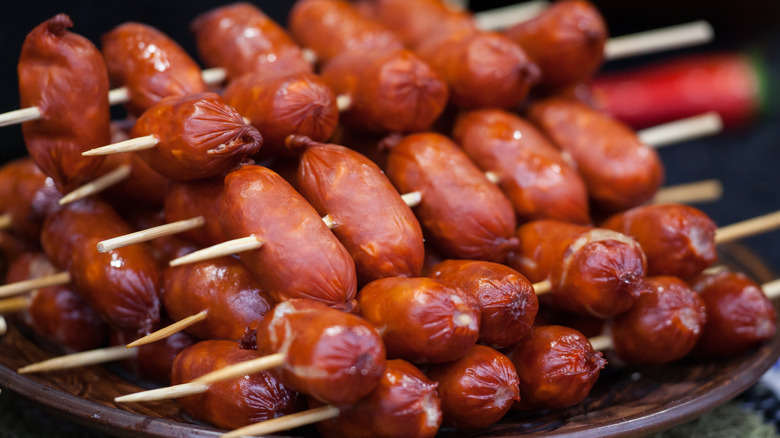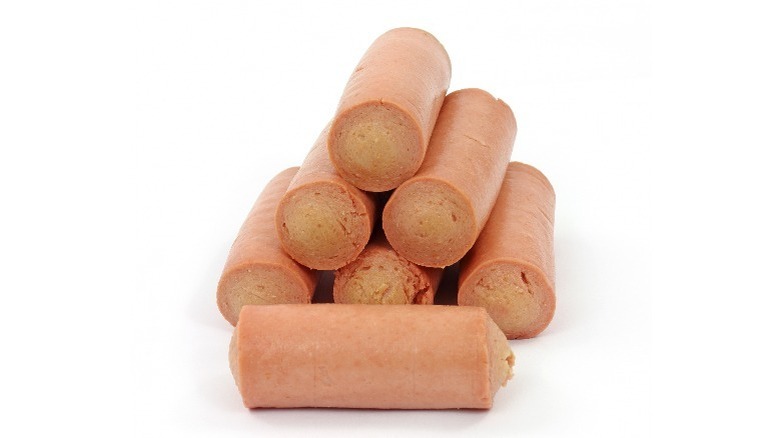How Vienna Sausage Differs In Korea And The US
Koreans were introduced to sausages when they got their first taste of Spam during the Korean War. Canned goods brought by American G.I.s were given away, and the most valuable ones contained processed mystery meats. During the war, all Korean agriculture was put on hold, so these rations were a primary source of sustenance. Interestingly enough, Spam and sausages were among the meats that the soldiers had absolutely no taste for. Thus, they were embraced by Koreans, who were both intrigued and delighted by the form and flavor of the precooked meat.
While these rations appear to be sad substitutes to prime cuts of meat, Koreans actually enjoyed them very much, along with other goods like beans and powdered milk. A look at contemporary Korean cuisine sheds light on this unabashed love for American imports. Koreans pour pounds of shredded mozzarella on just about everything, Spam is quintessential to the packed lunch, and they still love the iconic army stew — known as budae jjigae in Korean — a dish that emerged during wartime.
While there is a known nostalgia for their first encounter with Vienna sausages, Koreans branched out and developed their own version of the canned wiener that tastes quite different.
Korean Vienna sausages
First off, Korean Vienna sausages do not come in cans. They're sold like other sausages, vacuum-sealed, and placed in the refrigerated section of the store. These mini links have a noticeable casing, making them closer to bratwursts in flavor and texture. The sausage skin is slightly thick, and when cooked, it becomes delectably crispy so that the taut exterior bursts once bitten into.
Hence their alternate name, Tong Tong sausage — which is derived from "Tong Tong," an onomatopoeia for a popping sound that occurs when something ruptures or bursts. Korean cold meats tend to be less salty than those found in the U.S. and elsewhere, making these sausages quite mild. Their pork fillings are also less uniform than those found in wieners and sausages in the States. You'll find that the insides are much juicier with every bite since there are noticeable pockets of chewy fat embedded within them. Further, the meat itself tastes more smoked and meaty than a canned Vienna sausage does.
Korean Vienna sausages are often eaten as a "banchan" or side dish with a bowl of steamed rice. They're typically scored along one side and fried before being served plain with rice and egg. Or they are used in a ketchup sausage stir fry with onions and bell peppers for a classic Korean lunch box meal. At times, you'll find these little Vienna sausages on mini skewers — they are known as sotteok sotteok, a sweet and spicy sausage and rice cake snack.
American Vienna Sausages (Libby's)
Although Koreans have an affinity for their version of the bite-sized sausages, some still have a nostalgic connection to the first Vienna sausages they were introduced to: The classic Libby's Vienna sausages from America. On average, however, Americans tend to be much less enthusiastic about their Vienna sausages.
These soft, salty meat snacks are made out of a blend of chicken, beef, and pork, usually sealed in cans with chicken broth. These sausages are reminiscent of pate, as they mash very easily and have no bite to them. While the Korean version has pockets of fat deposits, Libby's is homogeneously pink and smooth throughout.
Although they are plainer in appearance and texture than Korean Vienna sausages, they still hold a place in American and Korean hearts alike. Children eat them as snacks, popping them in their mouths during breaks at school. While they serve as versatile ingredients for appetizers or finger foods, Vienna sausages can always be eaten straight from the can.
Some Korean Americans add Libby's Vienna sausages to their army stew aka budae jjigae, and it fits in perfectly with the array of salty meats in the dish.


